Why this? I explain:
A few months ago, I went out to drink with a couple of friends. One of them, knowing my interests, showed me the start of a very long video by a French youtuber about Mark Z. Danielewski’s book House of Leaves. I had never heard of this before, but as we watched more of the video it became apparent that the book was written in a way that corresponded to many things that get me going, literarily speaking. Having looked on the internet, there seems to be a whole load of interesting stuff about this genre, named ergodic by some, that I thought might make for an interesting read, if nothing else.
What is this? Espen J. Aarseth explains:
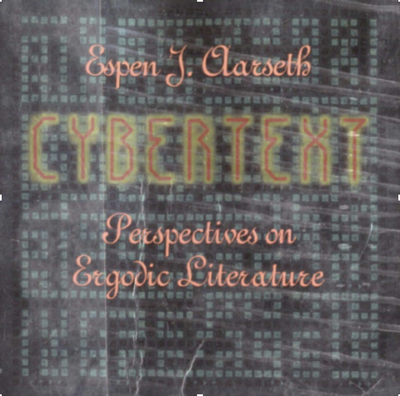 A few words on the two neoteric terms, cybertext and ergodic, are in order. Cybertext is a neologism derived from Norbert Wiener’s book (and discipline) called Cybernetics, and subtitled Control and Communication in the Animal and the Machine (1948). Wiener laid an important foundation for the development of digital computers, but his scope is not limited to the mechanical world of transistors and, later, of microchips. As the subtitle indicates, Wiener’s perspective includes both organic and inorganic systems; that is, any system that contains an information feedback loop. Likewise, the concept of cybertext does not limit itself to the study of computer-driven (or “electronic”) textuality; that would be an arbitrary and unhistorical limitation, perhaps comparable to a study of literature that would only acknowledge texts in paper-printed form. While there might be sociological reasons for such a study, we would not be able to claim any understanding of how different forms of literature vary. The concept of cybertext focuses on the mechanical organization of the text, by positing the intricacies of the medium as an integral part of the literary exchange. However, it also centers attention ….A_ on the consumer, or user, of the text, as a more integrated figure ~ than even reader-response theorists would claim. The performance of their reader takes place all in his head, while the user of cybertext also performs in an extranoematic sense. During the cybertextual process, the user will have effectuated a semiotic sequence, and this selective movement is a work of physical construction that the various concepts of “reading” do not account for. This phenomenon I call ergodic, using a term appropriated from physics that derives from the Greek words ergon and hodos, meaning “work” and “path.” In ergodic literature, nontrivial effort is required to allow the reader to traverse the text. If ergodic literature is to make sense as a concept, there must also be nonergodic literature, where the effort to traverse the text is trivial, with no extranoematic responsibilities placed on the reader except (for example) eye movement and the periodic or arbitrary turning of pages.
A few words on the two neoteric terms, cybertext and ergodic, are in order. Cybertext is a neologism derived from Norbert Wiener’s book (and discipline) called Cybernetics, and subtitled Control and Communication in the Animal and the Machine (1948). Wiener laid an important foundation for the development of digital computers, but his scope is not limited to the mechanical world of transistors and, later, of microchips. As the subtitle indicates, Wiener’s perspective includes both organic and inorganic systems; that is, any system that contains an information feedback loop. Likewise, the concept of cybertext does not limit itself to the study of computer-driven (or “electronic”) textuality; that would be an arbitrary and unhistorical limitation, perhaps comparable to a study of literature that would only acknowledge texts in paper-printed form. While there might be sociological reasons for such a study, we would not be able to claim any understanding of how different forms of literature vary. The concept of cybertext focuses on the mechanical organization of the text, by positing the intricacies of the medium as an integral part of the literary exchange. However, it also centers attention ….A_ on the consumer, or user, of the text, as a more integrated figure ~ than even reader-response theorists would claim. The performance of their reader takes place all in his head, while the user of cybertext also performs in an extranoematic sense. During the cybertextual process, the user will have effectuated a semiotic sequence, and this selective movement is a work of physical construction that the various concepts of “reading” do not account for. This phenomenon I call ergodic, using a term appropriated from physics that derives from the Greek words ergon and hodos, meaning “work” and “path.” In ergodic literature, nontrivial effort is required to allow the reader to traverse the text. If ergodic literature is to make sense as a concept, there must also be nonergodic literature, where the effort to traverse the text is trivial, with no extranoematic responsibilities placed on the reader except (for example) eye movement and the periodic or arbitrary turning of pages.
Is this Ergodic? An excerpt from a ‘Choose Your Own Adventure Story’ I wrote for my English class when I was 10 years old.
Page 8
You approach the forest with your trusty sword in hand and shield slung on your back. It is a dense misty morning with the murk rising in great tendrils of vapour so thick that you cannot see anything further than a yard away…
The forest looks evil in the dim light, you can almost hear the trees whispering curses at you and suddenly, you hover on the thought of returning… But the vision of Perseus’ smiling face is conjured up in your mind and a gut wrenching pain of loss and misery grips your heart. You must not abandon him. Taking one last look south you leave the plain of grass and plunge into the gaping mouth of the forest.
You are now following a little-used track through the forest. You look around you and see gnarled trees smothering their arms above you. The very air is hot and heavy. The pungent smell of wet leaves clings to your nostrils. Nothing makes the slightest sound.
Suddenly, a rustle of leaves disturbs the silence. Petrified you nearly jump out of your skin. An ice-cold feeling of fear and dread clamps over your heart. Timidly you call out, “Who’s there?”Nothing replies…
Quick as lightning a rough, brown hand grabs your sword, with one intricate flicking gesture pulls it out of your sheath. You turn around to be met with the overpowering stench of wine and mud mixed together. Forcing yourself to open your eyes you see a short, fat little man with horrible grey watery eyes, a face so dirty that mould has actually grown on it, pointed ears and dressed in filthy rags. He says in a horrible rasping voice, “Well, Well, Well, Wot ‘ave we ‘ere”
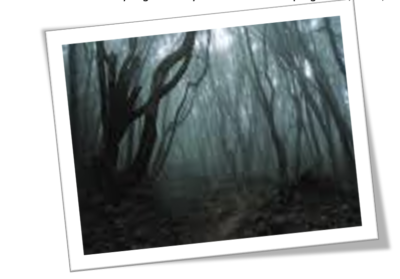
TO SCREAM FOR HELP, GO TO PAGE 15…
TO STAND AND FIGHT, GO TO PAGE 7…
Okay, so this is pretty naïve and rudimentary, but let’s see how the masters do it –
Section 1: How the Ancients Did It
Wall inscriptions on tombs/temples in Ancient Egypt
 There’s a throwaway reference to this in the Espen J. Aarspeth book, and I haven’t been able to find any more substantive stuff on this. At a guess, I imagine that the narratives portrayed are constructed depending on how you move through the space, kind of like a video game? Who knows though.
There’s a throwaway reference to this in the Espen J. Aarspeth book, and I haven’t been able to find any more substantive stuff on this. At a guess, I imagine that the narratives portrayed are constructed depending on how you move through the space, kind of like a video game? Who knows though.
Section 2: Prose and Poetry
Guillaume Apollinaire, Calligrammes
From Wikipedia:
Calligrammes: Poems of Peace and War 1913-1916, is a collection of poems by Guillaume Apollinaire which was first published in 1918 (see 1918 in poetry). Calligrammes is noted for how the typeface and spatial arrangement of the words on a page plays just as much of a role in the meaning of each poem as the words themselves – a form called a calligram. In this sense, the collection can be seen as either concrete poetry or visual poetry. Apollinaire described his work as follows:
The Calligrammes are an idealisation of free verse poetry and typographical precision in an era when typography is reaching a brilliant end to its career, at the dawn of the new means of reproduction that are the cinema and the phonograph.

Mark Saporta, Composition No. 1
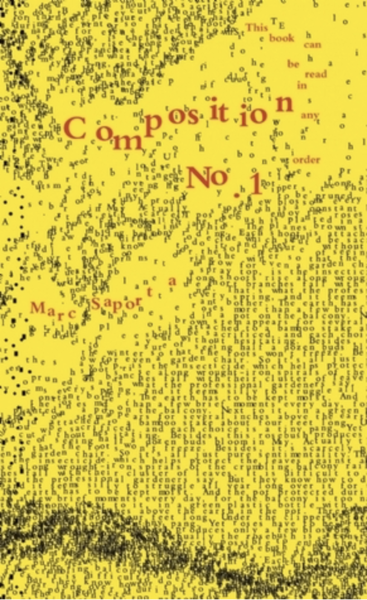 INTRODUCTION TO A REVIEW
INTRODUCTION TO A REVIEW
“Dagmar steps back to consider the effect. The canvas is covered with a thick layer of black paint, on which brilliant patches explode like flowers or rockets, long striations that rush to meet each other. The whole forms a strange, difficult, overpowering composition. Nothing in the painting suggests the young woman’s measured movements, her exact and firm gentleness.”
These were the first words of Marc Saporta’s Composition No 1 that I read, and it’s not a bad opening paragraph at all: economical, lyrical, and intriguing. There’s a slight problem with it, all the same – because with this novel, there is no way of knowing if this is meant to be the opening paragraph or not.
In fact Saporta’s novel has 150 opening paragraphs, because it consists of 150 unbound pages, printed on one side only, which the reader is meant to shuffle and read in any order. It is an extreme example of aleatory or interactive literature, that tiny but fascinating sub-genre which numbers among its better-known examples Hopscotch by Julio Cortázar, Landscape Painted with Tea by the Serbian novelist Milorad Pavic and – perhaps most famously in this country – BS Johnson’s The Unfortunates.
**Allegedly the first ever ‘book in a box’

Raymond Queneau, One Hundred Thousand Billion Poems
http://www.growndodo.com/wordplay/oulipo/10%5E14sonnets.html
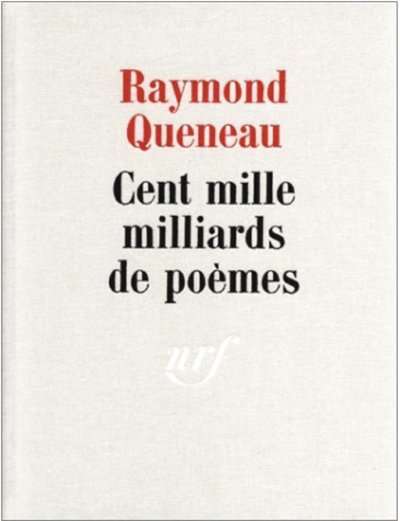 Raymond Queneau’s Hundred Thousand Billion Poems or One hundred million million poems (original French title: Cent mille milliards de poèmes), published in 1961, is a set of ten sonnets. They are printed on card with each line on a separated strip, like a heads-bodies-and-legs book. As all ten sonnets have not just the same rhyme scheme but the same rhyme sounds, any lines from a sonnet can be combined with any from the nine others, so that there are 1014 (= 100,000,000,000,000) different poems. It would take some 200,000,000 years to read them all, even reading twenty-four hours a day.
Raymond Queneau’s Hundred Thousand Billion Poems or One hundred million million poems (original French title: Cent mille milliards de poèmes), published in 1961, is a set of ten sonnets. They are printed on card with each line on a separated strip, like a heads-bodies-and-legs book. As all ten sonnets have not just the same rhyme scheme but the same rhyme sounds, any lines from a sonnet can be combined with any from the nine others, so that there are 1014 (= 100,000,000,000,000) different poems. It would take some 200,000,000 years to read them all, even reading twenty-four hours a day.
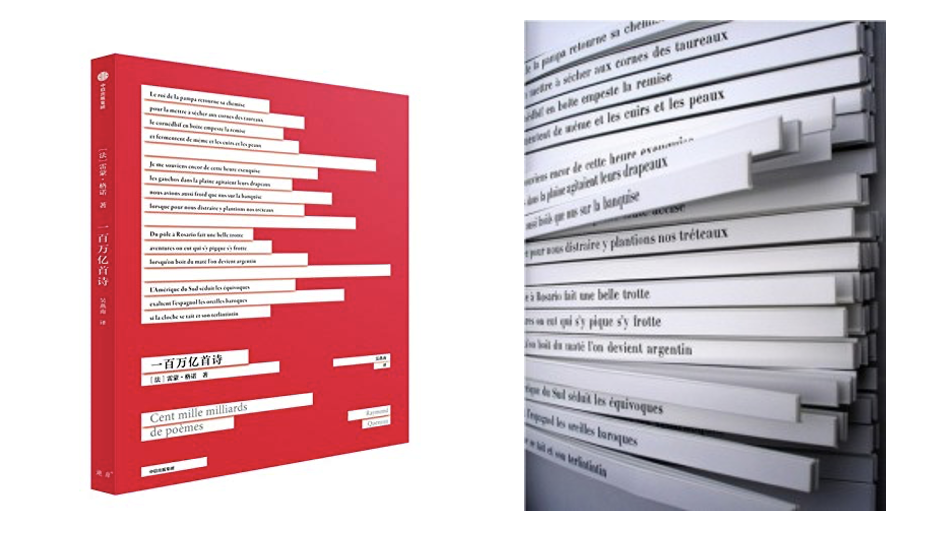
There is a virtual simulator available at http://www.growndodo.com/wordplay/oulipo/10%5E14sonnets.html
B. S. Johnson, The Unfortunates
“I did not think then, and do not think now, that this solved the problem completely… But I continue to believe that my solution was nearer; and even if it was only marginally nearer, then it was still a better solution to the problem of conveying the mind’s randomness than the imposed order of a bound book.”
A sports journalist, sent to a Midlands town on a weekly assignment, finds himself confronted by ghosts from the past when he disembarks at the railway station. Memories of one of his best, most trusted friends, a tragically young victim of cancer, begin to flood through his mind as he attempts to go about the routine business of reporting a football match.
B S Johnson’s famous ‘book in a box’, in which the chapters are presented unbound, to be read in any order the reader chooses, is one of the key works of a novelist now undergoing an enormous revival of interest. The Unfortunates is a book of passionate honesty and dark, courageous humour: a meditation on death and a celebration of friendship which also offers a remarkably frank self-portrait of its author.
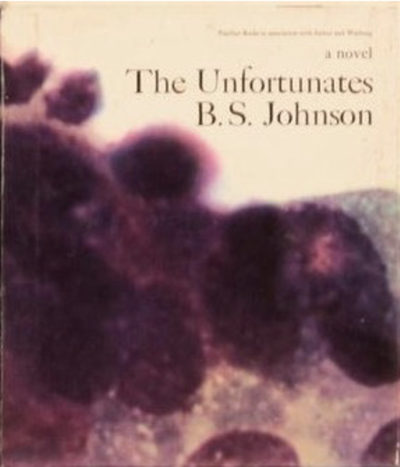
Arno Schmidt, Bottom’s Dream
Bottom’s Dream (German: Zettel’s Traum or ZETTEL’S TRAUM as the author wrote the title) is a novel published in 1970 by West German author Arno Schmidt. Schmidt began writing the novel in December 1963 while he and Hans Wollschläger began to translate the works of Edgar Allan Poe into German. The novel was inspired by James Joyce’s novel Finnegans Wake, particularly Schmidt’s use of columns (his “SpaltenTechnik”), which Schmidt claimed was borrowed from the Wake.
The story itself is based on the questions of translating Edgar Allan Poe, following a couple who visits the home of a Poe translator to discuss his work. It is written in an idiosyncratic style, one in which Schmidt attempts to apply a Freudian understanding of language to the text by using various typographic features which alter the usual flow of text.
The gargantuan novel was published in folio format with 1,334 pages. The story is told mostly in three shifting columns, presenting the text in the form of notes, collages, and typewritten pages.The 2016 English translation by John E. Woods has 1,496 pages and weighs over six kilograms.
*It also costs a cool 75 dollars!

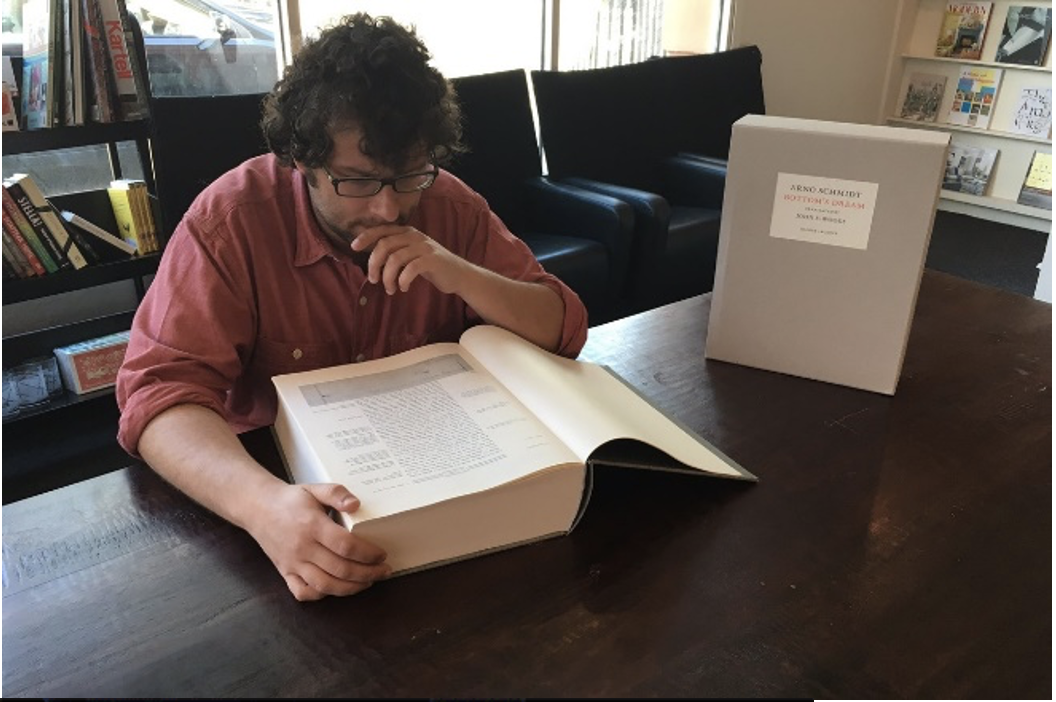

Milorad Pavić, Dictionary of the Khazars and Landscape Painted With Tea
 Dictionary of the Khazars: A Lexicon Novel (Serbian Cyrillic: Хазарски речник, Hazarski rečnik) is the first novel by Serbian writer Milorad Pavić, published in 1984. Originally written in Serbian, the novel has been translated into many languages. It was first published in English by Knopf, New York in 1988.
Dictionary of the Khazars: A Lexicon Novel (Serbian Cyrillic: Хазарски речник, Hazarski rečnik) is the first novel by Serbian writer Milorad Pavić, published in 1984. Originally written in Serbian, the novel has been translated into many languages. It was first published in English by Knopf, New York in 1988.
There is no easily discerned plot in the conventional sense, but the central question of the book (the mass religious conversion of the Khazar people) is based on a historical event generally dated to the last decades of the 8th century or the early 9th century when the Khazar royalty and nobility converted to Judaism, and part of the general population followed. There are more or less three different significant time-periods that take place in the novel. The first period takes place between the 7th and 11th centuries and is mainly composed of the stories of the polemic, its representatives and the Khazars themselves. The second period takes place during the 17th century, and includes stories about the lives of the compilers of the in-universe Khazar Dictionary and their contemporaries. The third briefly takes place in the 1960s and 70s, but mostly in the 1980s, and includes stories of academics of areas that are in some way to do with the Khazars. There are also mentions of things that happened outside of these periods, such as the talk of primordial beings like Adam Ruhani and Adam Cadmon.
Most of the characters and events described in the novel are entirely fictional, as is the culture ascribed to the Khazars in the book, which bears little resemblance to any literary or archeological evidence.
The novel takes the form of three cross-referenced mini-encyclopedias, sometimes contradicting each other, each compiled from the sources of one of the major Abrahamic religions (Christianity, Islam, and Judaism). In his introduction to the work, Pavić wrote:
No chronology will be observed here, nor is one necessary. Hence each reader will put together the book for himself, as in a game of dominoes or cards, and, as with a mirror, he will get out of this dictionary as much as he puts into it, for you […] cannot get more out of the truth than what you put into it.
The book comes in two different editions, one “male” and one “female”, which differ in only a critical passage in a single paragraph.
Pavić stated that the Khazars were a metaphor for a small people surviving in between great powers and great religions. In Yugoslavia, Serbs recognized their own fate; it was the same in Slovenia and elsewhere, a schoolbook on survival. The same in Hungary and Czechoslovakia, and on and on. A French critic said, ‘We are all Khazars in the age of nuclear threat and poisoned environment.
A ballet interpretation
Ibid., Landscape Painted with Tea
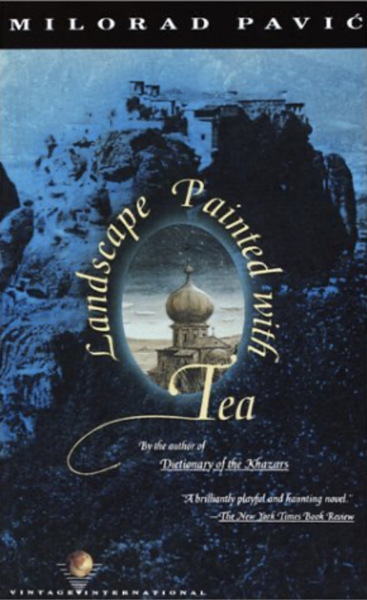 The present and the past, generation gaps, religion and faith, relationships of sexes: Landscape Painted with Tea consists of heterogeneous fragments and they don’t add up into the whole smoothly…
The present and the past, generation gaps, religion and faith, relationships of sexes: Landscape Painted with Tea consists of heterogeneous fragments and they don’t add up into the whole smoothly…
This novel can indeed be read in the same way that one does a crossword. Across here, down there, a name here, a surname there…
And like a crossword it doesn’t strive after having much sense… It is an effervescent play of mind… It resembles a sort of some talking tree…
I like the talking tree best; it alone bears a double fruit, and on it one can distinguish between quiet and silence. For a man with a heart full of silence and a man with a heart full of quiet cannot be alike…
“…any virtue is just a way station between two vices.” – Probably this is the quintessence of the story…
Or perhaps simply this: “He took along just one family icon John the Baptist Shaving His Chopped Off Head.”
This style of the Slavic magical realism rather resembles surrealism with a strong flavor of absurdist comedy…
But as the water in a cup is after all similar to the water in the sea so any tale, however surreal it may seem, is in some degree similar to reality.
House Of Leaves, Mark Z. Danielewski
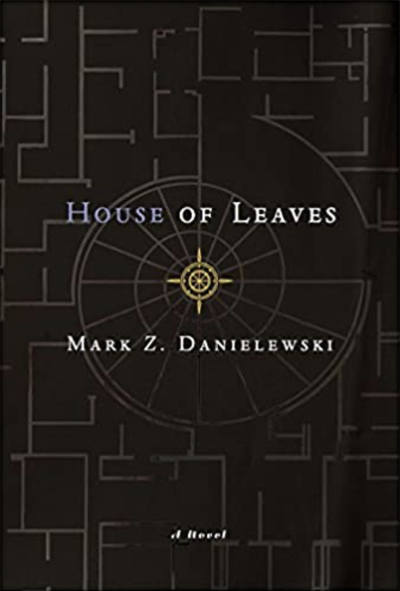 The plot is centered on a fictional documentary about a family whose house contains a seemingly endless labyrinth. The format and structure of House of Leaves is unconventional, with unusual page layout and style, making it a prime example of ergodic literature. It contains copious footnotes, many of which contain footnotes themselves, including references to fictional books, films or articles. In contrast, some pages contain only a few words or lines of text, arranged in strange ways to mirror the events in the story, often creating both an agoraphobic and a claustrophobic effect. At points, the book must be rotated to be read. The novel is also distinctive for its multiple narrators, who interact with each other in elaborate and disorienting ways. (Wikipedia)
The plot is centered on a fictional documentary about a family whose house contains a seemingly endless labyrinth. The format and structure of House of Leaves is unconventional, with unusual page layout and style, making it a prime example of ergodic literature. It contains copious footnotes, many of which contain footnotes themselves, including references to fictional books, films or articles. In contrast, some pages contain only a few words or lines of text, arranged in strange ways to mirror the events in the story, often creating both an agoraphobic and a claustrophobic effect. At points, the book must be rotated to be read. The novel is also distinctive for its multiple narrators, who interact with each other in elaborate and disorienting ways. (Wikipedia)
House of Leaves Changed My Life: The Cult Novel at 20
Danielewski’s House of Leaves Defies Literature
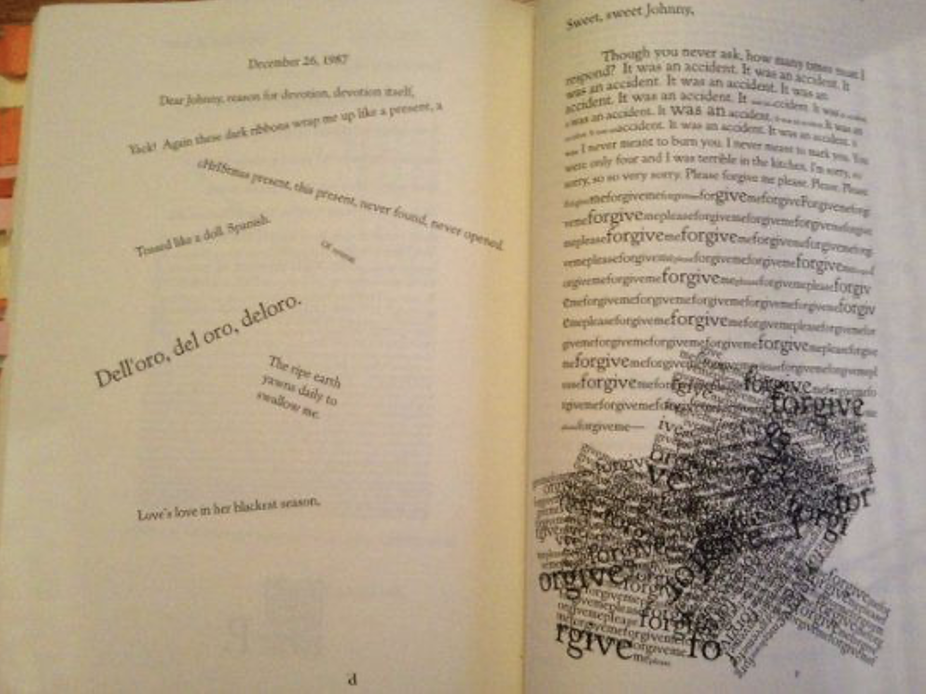
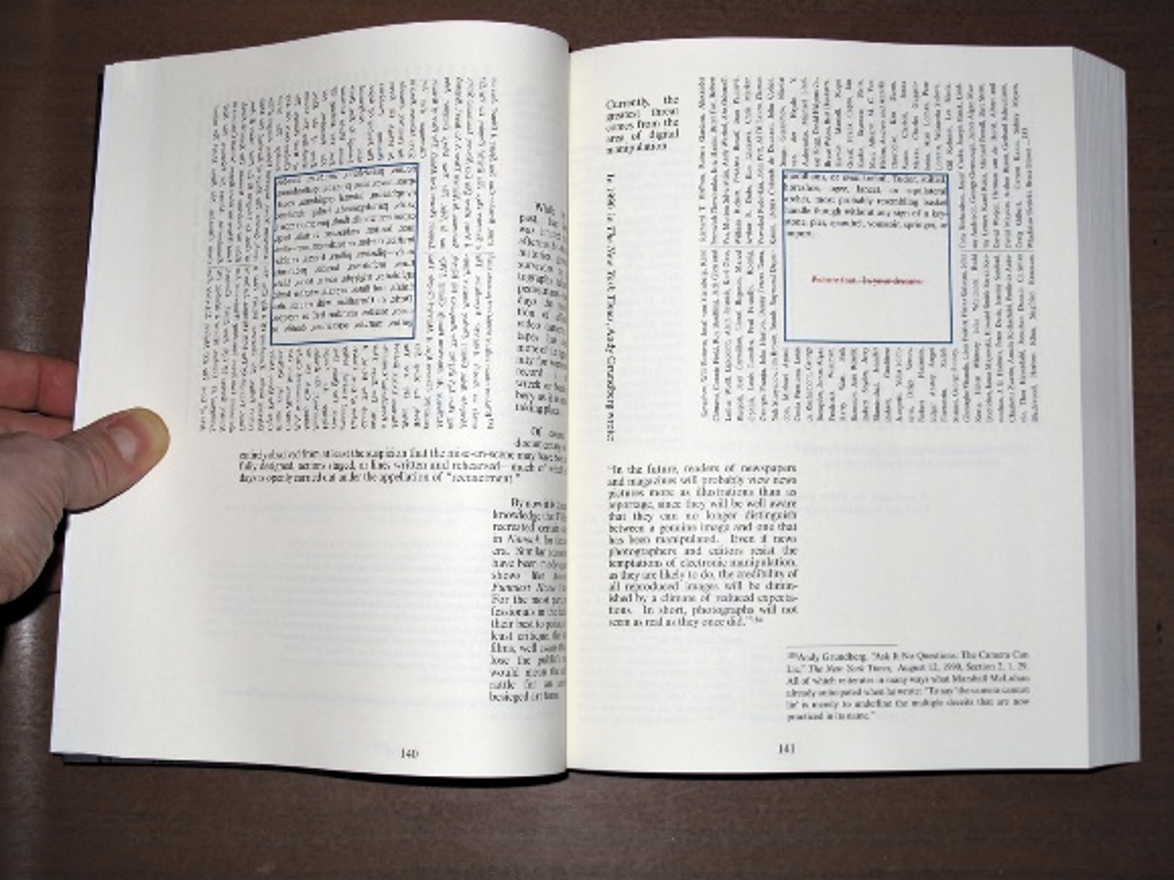

Vladimir Nabokov, Pale Fire
Pale Fire is a 1962 novel by Vladimir Nabokov. The novel is presented as a 999-line poem titled “Pale Fire”, written by the fictional poet John Shade, with a foreword, lengthy commentary and index written by Shade’s neighbor and academic colleague, Charles Kinbote. Together these elements form a narrative in which both fictional authors are central characters. Nabokov wrote Pale Fire in 1960–61, after the success of Lolita had made him financially independent, allowing him to retire from teaching and return to Europe. It was commenced in Nice and completed in Montreux, Switzerland.
…
Starting with the epigraph and table of contents, Pale Fire looks like the publication of a 999-line poem in four cantos (“Pale Fire”) by the fictional John Shade with a foreword, extensive commentary, and index by his self-appointed editor, Charles Kinbote. Kinbote’s commentary takes the form of notes to various numbered lines of the poem. Here and in the rest of his critical apparatus, Kinbote explicates the poem very little. Focusing instead on his own concerns, he divulges what proves to be the plot piece by piece, some of which can be connected by following the many cross-references. Espen Aarseth noted that Pale Fire “can be read either unicursally, straight through, or multicursally, jumping between the comments and the poem.” Thus, although the narration is non-linear and multidimensional, the reader can still choose to read the novel in a linear manner without risking misinterpretation.
…
The interaction between Kinbote and Shade takes place in the fictitious small college town of New Wye, Appalachia, where they live across a lane from each other, from February to July 1959. Kinbote writes his commentary from then to October 1959 in a tourist cabin in the equally fictitious western town of Cedarn, Utana. Both authors recount many earlier events, Shade mostly in New Wye and Kinbote in New Wye and in Europe, especially the “distant northern land” of Zembla.
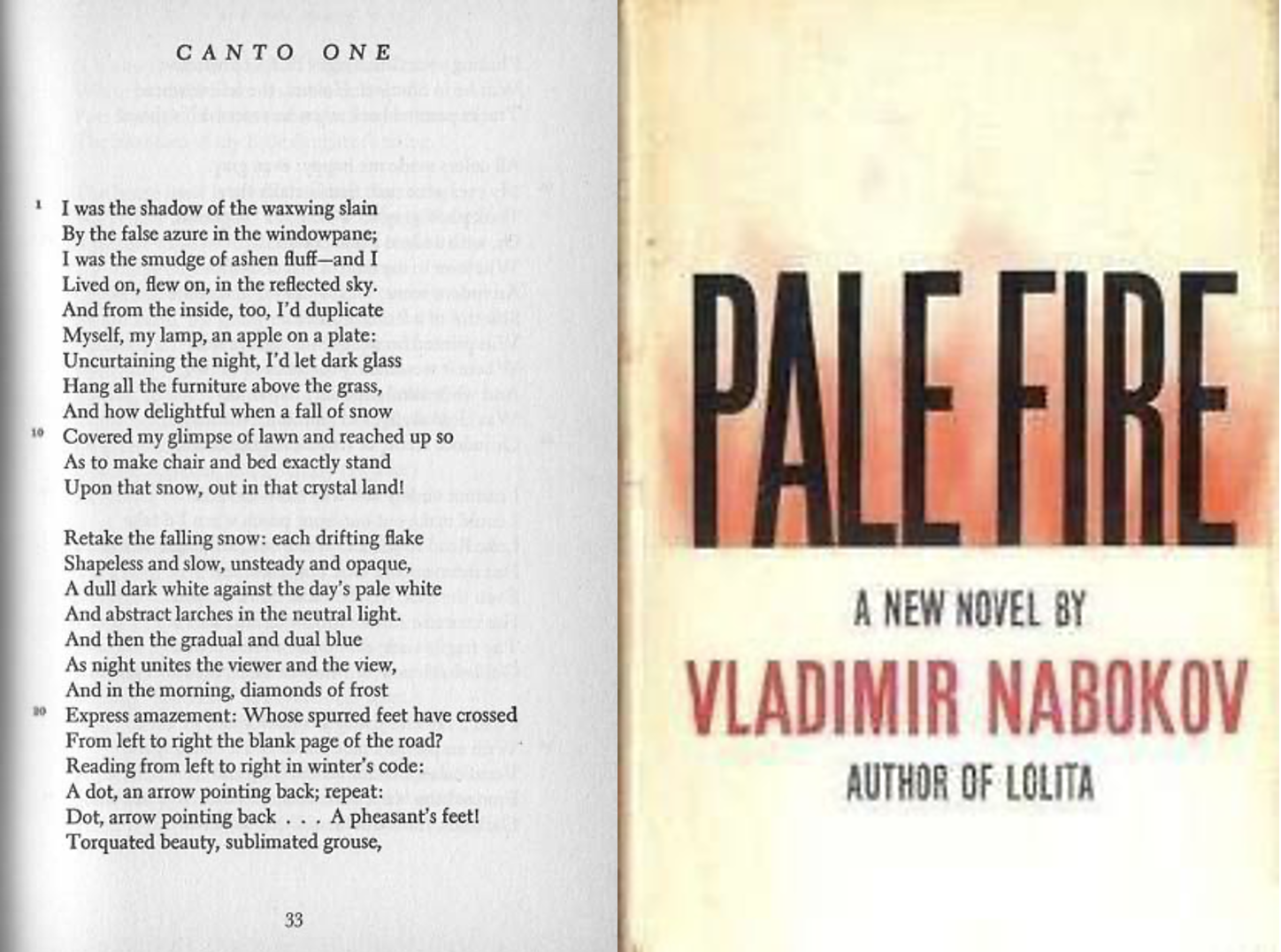
Solving Nabokov’s Pale Fire
*A CODA ON HTML FICTION – DEFINITELY ERGODIC BUT TOO MUCH TO CHOOSE FROM AND THE POST IS LONG ALREADY, HERE ARE TWO EXAMPLES FOR YOU
afternoon, a story, Michael Joyce
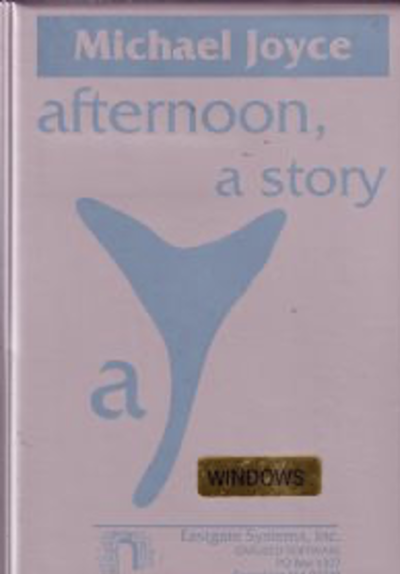 … spelled with a lowercase ‘a’, is a work of electronic literature written in 1987 by American author Michael Joyce. It was published by Eastgate Systems in 1990 and is known as one of the first works of hypertext fiction.
… spelled with a lowercase ‘a’, is a work of electronic literature written in 1987 by American author Michael Joyce. It was published by Eastgate Systems in 1990 and is known as one of the first works of hypertext fiction.
afternoon was first offered to the public as a demonstration of the hypertext authoring system Storyspace, announced in 1987 at the first Association for Computing Machinery Hypertext conference in a paper by Michael Joyce and Jay David Bolter. In 1990, it was published on diskette and distributed in the same form by Eastgate Systems. It was followed by a series of other Storyspace hypertext fictions, including Stuart Moulthrop’s Victory Garden, Shelley Jackson’s Patchwork Girl and Deena Larsen’s Marble Springs. Eastgate continues to publish the work in the 2010s and distributes it on a USB flash drive.
The original CD cover >>>>
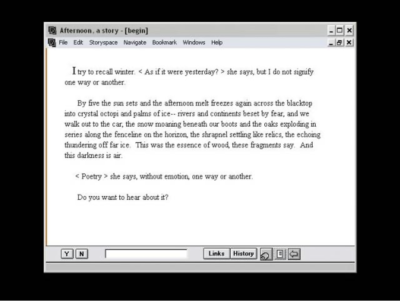
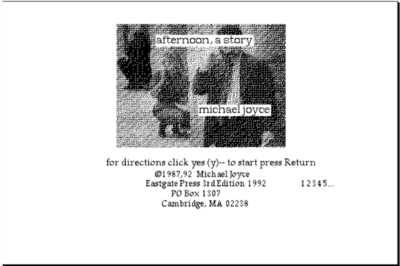
The hypertext fiction tells the story of Peter, a recently divorced man who witnessed a car crash. Hours later, he suspects that the wrecked car may have involved his ex-wife and their son.
The plot may change each time it is read if the reader chooses different paths. (Wikipedia)
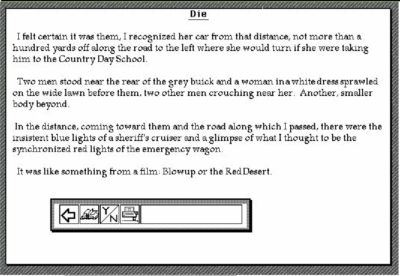
Patchwork Girl, or A Modern Monster, Shelley Jackson
by Shelley Jackson

Jackson’s Patchwork Girl tells the story through illustrations of parts of a female body that are stitched together through text and image. The narrative of the story is divided into five segments, titled: “a Graveyard”, “a Journal”, “a Quilt”, “a Story”, and “& broken accents.” The goal of the piece is to not only make the reader realize the structure of the Patchwork Girl as a whole but also realize all the pieces that must be “patched” together in order to create one unified structure. Each segment leads down a trail that takes the story in multiple directions through various linking words and images. Jackson uses recurring graveyard imagery in order to continually invite the reader to resurrect Mary Shelley’s monster.
In Mary Shelley’s original, Victor Frankenstein begins the creation of a female companion for his monster, but destroys the second effort prior to completion. In Jackson’s version, the female monster is completed by Mary Shelley herself. The woman and her creation become lovers; the creature then travels to America, where she pursues a variety of adventures before disintegrating after a 175-year lifetime. Individual sections also explore the lives of some of the women whose corpses contributed body parts to the creature. The work is an oft-cited example of cyberfeminism—”If you want to see the whole,” one passage reads, “you will have to piece me together yourself.” Furthermore, Jackson’s use of hypertext “enables us to recognize the degree to which the qualities of collage—particularly those of appropriation, assemblage, concatenation, and the blurring of limits, edges, and borders—characterize a good deal of the way we conceive of gender and identity.”
In reflecting on the structural impact of hypertext on Patchwork Girl, Jackson wrote:
In hypertext, everything is there at once and equally weighted. It is a body whose brain is dispersed throughout the cells, fraught with potential, fragile with indecision, or rather strong in foregoing decisions, the way a vine will bend but a tree can fall down. (Wikipedia)
Excerpts from a talk SJ made in
It has come to my attention that a young woman claiming to be the author of my being has been making appearances under the name of Shelley Jackson. It seems you have even invited her to speak tonight, under the misapprehension that she exists, that she is something besides a parasite, a sort of engorged and loathsome tick hanging off my side. May I say that I find this an extraordinary impertinence, and that if she would like to come forward, we shall soon see who is the author of whom.
…
We’re not who we say we are.
The body is not one, though it seems so from up here, from this privileged viewpoint up top. When we look down that assemblage of lobes and stalks seems to be one thing, even if it looks nothing like our ID photo, but it routinely survives dissolution, from hair loss to loss of limb. The body is a patchwork, though the stitches might not show. It’s run by committee, a loose aggregate of entities we can’t really call human, but which have what look like lives of a sort; though they lack the brains to nominate themselves part of the animal kingdom, yet they are certainly not what we think of as objects, nor are they simple appendages, directly responsible to the conscious brain. Watch white blood cells surround an invader, watch a cell divide. What we see is not thinking exactly, but it is “intelligent,” or at least ordered, responsive, purposeful.
…
The body is not even experienced as whole. We never see it all, we can’t feel our liver working or messages shuttling through our spine. We patch a phantom body together out of a cacophony of sense impressions, bright and partial views. We borrow notions from our friends and the blaring organs of commerce, and graft them on to a supple, undifferentiated mist of smart particles. It’s like a column of dust motes standing in a ray of light, patted and tatted into a familiar shape. Our work is never very successful, there are always scraps floating loose, bits we can’t control or don’t want to perceive that intrude like outsiders on the effigy we’ve constructed in our place. The original body is dissociated, porous and unbiased, a generous catch-all. The mind, on the other hand, or rather discursive thought, what zen calls monkey-mind and Bataille calls project, has an almost catatonic obsession with stasis, centrality, and unity. Project would like the body to be its commemorative statue or its golem, sober testiment to the minds’ values and an uncomplaining servant. But the statue doesn’t exist except in the mind, a hard kernel like a tumor, set up in the portal to the body, blocking the light. The project of writing, the project of life, even, is to dissolve that tumor. To dismantle the project is the project. That is, to interrupt, unhinge, disable the processes by which the mind, glorying in its own firm grip on what it wishes to include in reality, gradually shuts out more and more of it, and substitutes an effigy for that complicated machine for inclusion and effusion that is the self.
EVERYTHING AT ONCE
You’re not where you think you are. In hypertext, everything is there at once and equally weighted. It is a body whose brain is dispersed throughout the cells, fraught with potential, fragile with indecision, or rather strong in foregoing decisions, the way a vine will bend but a tree can fall down. It is always at its end and always at its beginning, the birth and the death are simultaneous and reflect each other harmoniously, it is like living in the cemetary and the hospital at once, it is easy to see the white rectangles of hospital beds and the white rectangles of gravestones and the white rectangles of pages as being essentially synonymous. Every page-moment is both expectant and memorializing, which is certainly one reason why I have buried the patchwork girl’s body parts in separate plots in a zone called the cemetary, while in the story zone they are bumptious and ambulatory.
Hypertext doesn’t know where it’s going. “Those things which occur to me, occur to me not from the root up but rather only from somewhere about their middle. Let someone then attempt to seize them, let someone attempt to seize a blade of grass and hold fast to it when it begins to grow only from the middle,” said Kafka. It’s got no through-line. Like the body, it has no point to make, only clusters of intensities, and one cluster is as central as another, which is to say, not at all. What sometimes substitutes for a center is just a switchpoint, a place from which everything diverges, a Cheshire aftercat. A hypertext never seems quite finished, it isn’t clear just where it ends, it’s fuzzy at the edges, you can’t figure out what matters and what doesn’t, what’s matter and what’s void, what’s the bone and what’s the flesh, it’s all decoration or it’s all substance. Normally when you read you can orient yourself by a few important facts and let the details fall where they may. The noun trumps the adjective, person trumps place, idea trumps example. In hypertext, you can’t find out what’s important so you have to pay attention to everything, which is exhausting like being in a foreign country, you are not native.
Hypertext is schizophrenic: you can’t tell what’s the original and what’s the reference. Hierarchies break down into chains of likenesses, the thing is not more present than what the thing reminds you of; in this way you can slip out of one text into a footnoted text and find yourself reading another text entirely, a text to which your original text is a footnote. This is unnerving, even to me. The self may have no clear boundaries, but do we want to lose track of it altogether? I don’t want to lose the self, only to strip it of its claim to naturalness, its compulsion to protect its boundaries, its obsession with wholeness and its fear of infection. I would like to invent a new kind of self which doesn’t fetishize so much, grounding itself in the dearly-loved signs and stuff of personhood, but has poise and a sense of humor, changes directions easily, sheds parts and assimilates new ones. Desire rather than identity is its compositional principle. Instead of this morbid obsession with the fixed, fixable, everyone composing their tombstone over and over. Is it that we want to live up to the dignity of our dead bodies? Do keep in mind the dead disperse, and even books, which live longer, come apart into different signatures.
NO-PLACE
I’m not where you say I am.
Hypertext blurs the distinction between subject and object, matter and the absence of matter. We no longer know where it does its thinking, or what it is driving at. (It’s no one and no-place, but it’s not nothing. ) Instead, there is a communicating fabric spread out over a space without absolute extent, a place without placement (a place without placemats, I almost wrote, which is good too). In the no-place of hypertext, there’s finally room to move around, like an orifice I can fit my whole body into, instead of just my finger or my p-p-p-pen. I adore the book, but I don’t fit into it very well, as a writer or a reader, there’s always some of me hanging untidily outside, looking like a mess, an excrescence, something the editor should have lopped off and for which I feel a bit apologetic. To make something orderly and consecutive out of the divergent fragments that come naturally feels like forcing myself through a Klein bottle. My hypertext novel Patchwork Girl grew in clumps and strands like everything I write, but unlike everything else it had permission to stay that way, to grow denser and more articulated but not to reshape itself. (It made me slightly nervous. Maybe I puritanically half-believed I ought to button down, zip up.) I can’t help seeing an analogy between the editorial advice I have often received to weed out the inessentials and lop off the divergent story lines, and the life advice I’ve received just as often to focus, choose, specialize. You don’t show up for tennis in a tutu and a catcher’s mask, it’s silly. But in this place without coordinates I cautiously began to imagine that I could invent a new game, make a novel, if we still want to call it that, shaped a little more like my own thoughts. It is as though somebody chewed a hole in a solid and irrefutable wall, and revealed an expanse of no-space as extensive as the space we live in, or as though the interstices between things could be pried apart without disturbing the things themselves, to make room for what hasn’t been voted into the club of stuff.
GAPS, LEAPS
You won’t get where you think you’re going.
A conventional novel is a safe ride. It is designed to catch you up, propell you down its track, and pop you out at the other end with possibly a few new catchphrases in your pocket and a pleasant though vague sense of the scenery rushing by. The mechanism of the chute is so effective, in fact, that it undoes the most worthy experiments; sentences that ought to stop you in your tracks are like spider webs across the chute. You rip through, they’re gone.
Hypertext likes give and take, snares and grottos, nets and knots. It lacks thrust. It will always lack thrust; thrust is what linear narrative is good at. As far as I’m concerned, we can trust thrust to it. It means we’ll need other reasons to keep readers reading–assuming that’s what we want–than a compulsion to find out what happens next. There’s no question that hypertext will lose or never acquire those readers for whom a fated slalom toward the finish line is the defining literary experience; hypertext’s not built for that. Probably it is because linear text’s so well-built for it that it has become the dominant narrative style in the novel. But there are other reasons to read. I can be caught in that slalom myself, but I emerge feeling damp, winded and slightly disgusted. It is a not entirely pleasant compulsion disguised as entertainment, like being forced to dance by a magic fiddle. It becomes harder and harder to imagine going anywhere but just where you’re going, and words increasingly mean just what they say. (Common sense reality does the same thing: there is little opportunity for poetic ambiguity in the dealings of everyday life.) Plot chaperones understanding, cuts off errant interpretations. Reading a well-plotted novel I start by knowing less than I know about my own life, and being open to far more interpretations, which makes me feel inquisitive and alive. I finish by knowing more than I want to know, stuck on one meaning like a bug on a pin.
In a text like this, gaps are problematic. The mind becomes self-conscious, falters, forgets its way, might choose another way, might opt out of this text into another, might “lose the thread of the argument,” might be unconvinced. Transitional phrases smooth over gaps, even huge logical gaps, suppress contradiction, whisk you past options. I noticed in school that I could argue anything. I might find myself delivering conclusions I disagreed with because I had built such an irresistable machine for persuasion. The trick was to allow the reader only one way to read it, and to make the going smooth. To seal the machine, keep out grit. Such a machine can only do two things: convince or break down. Thought is made of leaps, but rhetoric conducts you across the gaps by a cute cobbled path, full of grey phrases like “therefore,” “extrapolating from,” “as we have seen,” giving you something to look at so you don’t look at the nothing on the side of the path. Hypertext leaves you naked with yourself in every leap, it shows you the gamble thought is, and it invites criticism, refusal even. Books are designed to keep you reading the next thing until the end, but hypertext invites choice. Writing hypertext, you’ve got to accept the possibility your reader will just stop reading. Why not? The choice to go do something else might be the best outcome of a text. Who wants a numb reader/reader-by-numbers anyway? Go write your own text. Go paint a mural. You must change your life. I want piratical readers, plagiarists and opportunists, who take what they want from my ideas and knot it into their own arguments. Or even their own novels. From which, possibly, I’ll steal it back.
BANISHED BODY
It’s not what we wish it were.
The real body, which we have denied representation, is completely inimical to our wishful thinking about the self. We would like to be unitary, controlled from on top, visible, self-contained. We represent ourselves that way, and define our failures to be so, if we cannot ignore them, as disease, hysteria, anomaly. However:
The banished body is unhierarchical.
It registers local intensities, not arguments. It is a field of sensations juxtaposed in space.
It is vague about size and location, unclear on measurements of all kinds, bad at telling time (though good at keeping it).
It is capacious, doesn’t object to paradox, includes opposites–doesn’t know what opposites are.
It is simultaneous.
It is unstable. It changes from moment to moment, in its experience both of itself and of the world.
It has no center, but a roving focus. (It “reads” itself.)
It is neither clearly an object nor simply a thought, meaning or spirit; it is a hybrid of thing and thought, the monkey in the middle.
It is easily influenced; it is largely for being influenced, since its largest organs are sensing devices.
It is permeable; it is entered by the world, via the senses, and can only roughly define its boundaries.
It reports to us in stories, intensities, hallucinatory jolts of uninterpreted perceptions: smells, sights, pleasure, pain.
Its public image, its face is a collage of stories, borrowed images, superstitions, fantasies. We have no idea what it “really” looks like.
Because we have banished the body, but cannot get rid of it entirely, we can use it to hold what we don’t want to keep but can’t destroy. The real body, madcap patchwork acrobat, gets what the mind doesn’t want, the bad news, the dirty stories. The forbidden stories get written down off-center, in the flesh. In hysteria, the body starts to tell those stories back to us–our kidneys become our accusers, our spine whines, our knees gossip about overheard words, our fingers invent a sign language of blame and pain. Of course, the more garbage we pack into that magical body the more we fear it, and the more chance there is that it will turn on us, begin to speak, accuse us. But that body-bag is also a treasure-trove, like any junkyard. It knows stories we’ve never told.
BOUNDARY PLAY
We don’t think what we think we think.
It’s straightforward enough to oppose the self to the not-self and reason to madness. It’s even possible to make the leap from here to there, though coming back presents some problems. But the borders between are frayed and permeable. It’s possible to wander that uneven terrain, to practice slipping, skidding in the interzone. It’s possible, and maybe preferable for the self to think of itself as a sort of practice rather than a thing, a proposition with variable terms, a mesh of relationships. It’s possible for a text to think of itself that way. ANY text. But hypertext in particular is a kind of amphibious vehicle, good for negotiating unsteady ground, poised on its multiple limbs where the book clogs up and stops; it keeps in motion. Conventional texts, on the other hand are in search of a place of rest; when they have found it, they stop.
Similarly, the mind, reading, wants to make sense, and once it has done so it considers its work done, so if you want to keep the mind from stopping there, you must always provide slightly more indicators than the mind can make use of. There must be an excess, a remainder. Or an undecideable oscillation between possibilities. I am interested in writing that verges on nonsense, where nonsense is not the absence of sense, but the superfluity of it. I would like to sneak as close to that limit as possible without reaching it. This is the old kind of interactive writing: writing so dense or so slippery that the mind must do a dance to keep a grip on it. I am interested in writing this way for two reasons. One, because language must be teased into displaying its entire madcap lavish beauty. If you let it be serviceable then it will only serve you, never master you, and you will only write what you already know, which is not much. Two, because the careful guarding of sense in language is not just analogous to but entirely complicit in the careful guarding of sense in life, and that possibly well-intentioned activity systematically squelches curiosity, change, variety, & finally, all delight in life. It promotes common sense at the expense of all the others.
REALITY FICTION
It’s not what it says it is.
Reality thinks it “includes” fiction, that fictional works are embedded in reality. It’s the boast of a bully. But just because reality’s bigger doesn’t make it boss. Every work of art is an alternate “world” with other rules, which threatens the alibi of naturalness our ordinary reality usually flaunts. Every fictional world competes with the real one to some extent, but hypertext gives us the chance to sneak up on reality from inside fiction. It may be framed as a novel, yet link to and include texts meant to be completely non-fictional. Thus the pedigreed facts of the world can be swayed, framed, made persuaders of fiction, without losing their seats in the parliament of the real, as facts tend to do when they’re stuck in a novel. Hypertext fiction thus begins to turn around and look back on reality as a text embedded in a fictional universe.
Ironically, that might make us like reality better: it’s reality’s hegemony that strips it of charm. Reality is based on country cottage principles: what’s homey must be true. It is a tolerable place to live. What’s dreadful is the homey on a grand scale, Raggedy Ann and Andy turned Adam and Eve, cross-stitch scenes of the Grand Canyon, the sun cast as the flame snapping behind the grate, the ocean our little kettle. Those goofy grins turn frightening on a cosmic scale; the simplicity that makes it easy to pick up a coffeecup is not suitable for managing a country, or even a conscience. The closure of the normal is suffocating at the very least. By writing we test the seams, pick out the stitches, trying to stretch the gaps between things to slip out through them into some uncharted space, or to let something spring up in the real that we don’t already know, something unfamiliar, not part of the family, a changeling.
THE FEMININE
She’s not what he says she is. The banished body is not female, necessarily, but it is feminine. That is, it’s amorphous, indirect, impure, diffuse, multiple, evasive. So is what we learned to call bad writing. Good writing is direct, effective, clean as a bleached bone. Bad writing is all flesh, and dirty flesh at that: clogged with a build-up of clutter and crud, knick-knacks and fripperies encrusted on every surface, a kind of gluey scum gathering in the chinks. Hypertext is everything that for centuries has been damned by its association with the feminine (which has also, by the way, been damned by its association with it, in a bizarre mutual proof without any fixed term). It’s dispersed, languorous, flaunting its charms all over the courtyard. Like flaccid beauties in a harem, you might say, if you wanted to inspire a rigorous distaste for it. Hypertext then, is what literature has edited out: the feminine. (That is not to say that only women can produce it. Women have no more natural gift for the feminine than men do.)
CONSTELLATION
I’m not what you think I am. I am a loose aggregate, a sort of old fashioned cabinet of curiosities, interesting in pieces but much better as a composite. It’s the lines of traffic between the pieces that are worth attention, but this has been, until now, a shapeless sort of beauty, a beauty without a body, and therefore with few lovers. But hypertext provides a body, a vaporous sort of insufficiently tactile body but a body, for our experience of the beauty of relationships. It is like an astronomy of constellations rather than stars. It is old-fashioned, in that sense. It is a sort of return, to a leisurely old form, the sprawling, quizzical portmanteau book like the Anatomy of Melancholy ( “a rhapsody of rags gathered together from several dung-hills, excrements of authors, toys and fopperies confusedly tumbled out,” as Burton himself described it) to the sort of broad cross-fertilization of disciplines that once was commonplace, only hypertext does not provide so much courtly guidance across the intellectual terrain, but catapults you from spot to spot. (The wind whistles in your ears. It aerates the brain. You begin to feel like a circus performer, describing impeccable parabolas in the air, vacating every gesture before it can be fixed, wherever anyone thinks you are is where you’ve just been, sloughing off afterimages. You feel pared down, athletic, perfectly efficient.) The athletic leap across divides has its own aesthetic, and so does the pattern those leaps form in the air, or, to be more exact, in the mind. People spend their lives forging such patterns for themselves, but only the cranks and the encyclopedic generalists with vague job descriptions, the Bill Moyerses, have the nerve to invite others to try out their own hobby-horseride through the World of Ideas. More often these are private pathways, possible to make out sometimes in a novelist’s ouevre (rare butterflies turn up in Nabokov’s fiction enough to make you guess that he was a lepidopterist, if you didn’t know already) as a system of back alleys heading off from the work at hand, but not for public transit. Until recently, that is, since the internet seems to be making possible a gorgeous excess of personal syntactical or neural maps, like travel brochures for the brain. What results isn’t necessarily worth the trip, but some of it will be: art forms take shape around our ability to perceive beauty, but our ability to perceive beauty also takes shape around what forms become possible. Hypertext is making possible a new kind of beauty, and creating the senses to perceive it with.
COLLAGE
We don’t say what we mean to say. The sentence is not one, but a cluster of contrary tendencies. It is a thread of DNA–a staff of staphylococcus–a germ of contagion and possibility. It may be looped into a snare or a garotte. It is also, and as readily, a chastening rod, a crutch, an IDJbracelet. It is available for use. But nobody can domesticate the sentence completely. Some questionable material always clings to its members. Diligent readers can glean filth from a squeaky-clean one. Sentences always say more than they mean, so writers always write more than they know, even the laziest of them. Utility pretends to peg words firmly to things, but it is easy to work them loose. “Sometimes the words are unfaithful to the things,” says Bachelard. Indeed they are, and as writers, we are the agents of misrule, infidelity, broken marriages. It was not difficult, for example, to pry quotes from their sources, and mate them with other quotes in the “quilt” section of Patchwork Girl, where they take on a meaning that is not native to the originals. We set up rendezvous between words never before seen in company, we provide deliciously private places for them to couple. Like the body, language is a desiring machine. The possibility of pollution is its only life. Having invented an infinitely recombinant language, we can’t prevent it from forming improper alliances, any more than we can seal all our orifices without dying.
In collage, writing is stripped of the pretense of originality, and appears as a practise of mediation, of selection and contextualization, a practise, almost, of reading. In which one can be surprised by what one has to say, in the forced intercourse between texts or the recombinant potential in one text, by the other words that mutter anagrammatically inside the proper names. Writers court the sideways glances of sentences mostly bent on other things. They solicit bad behavior, collusion, conspiracies. Hypertext just makes explicit what everyone does already. After all, we are all collage artists. You might make up a new word in your lifetime–I nominate “outdulge”: to lavish fond attention on the world, to generously broadcast care–but your real work will be in the way you arrange all the stuff you borrow, the buttons and coins, springs and screws of language, the frames and machinery of culture. We might think of Lawrence Sterne, who, when accused of plagiarism, answered the charge with an argument that was itself a plagiarism.
WE LIKE TO MAKE STATUES
We are not who we wish we were.
We like to make statues of ourselves. The Greeks marched ever more perfect bodies out of antiquity, slim vertical columns, like a line of capital I’s, a stutter of self-assertion. But works of words are self-portraits too, substitute bodies we put together, then look to for encouragement. Boundaries of texts are like boundaries of bodies, and both stand in for the confusing and invisible boundary of the self. The wholeness of an artwork helps firm us up; in its presence we believe a little more in the unity we uneasily suspect we lack. As a result we have an almost visceral reaction to disorderly texts. Good writing is clear and orderly; bad writing inspires the same kind of distaste that bad grooming does, while experimental novels are not just hard to read, they’re anti-social. Proper novels are duplicate bodies to the idealized ones we have in our heads, the infamous “thin person struggling to get out.” They’re good citizens, polite dinner guests.
Books, of course, like other bodies, fall apart. Literally, and also in the invisible body of the text, because language is libidinous, and the most strait-laced sentence hides a little hanky-panky under the dust ruffle. But monkey brain doesn’t want to think about that, project can’t hear, and so the novel, over the course of time, has become, despite the most flagrant tendecies toward polymorphous perversity and transgender play, a very stalwart announcement of nothing much. A sturdy who cares. One writes, one produces literature, and as Bataille says, “one day one dies an idiot.” A project without any particular purpose that I can see, besides the announcement that project exists, that there is purpose and order, a sort of recitation of what we already know. The novel has become the golem, the monster that acts like everyone else, only better, because the narrative line is wrapped like a leash around its thick neck. I would like to introduce a different kind of novel, the patchwork girl, a creature who’s entirely content to be the turn of a kaleidoscope, an exquisite corpse, a field on which copulas copulate, the chance encounter of an umbrella and a sewing machine on an operating table. The hypertext.
Hypertext is the banished body. Its compositional principle is desire. It gives a loudspeaker to the knee, a hearing trumpet to the elbow. It has the stopped stories to tell, it mentions unmentionables, speaks unspeakables; it unspeaks. I don’t mean to say it has different, better opinions than novels can muster up, that it’s plugged with better content. Hypertext won’t make a bland sentence wild or make a dead duck run quacking for the finish line. Fill a disjunctive structure with pablum and you will only cement the world’s parts more solidly together, clog the works with glue. It’s not opinions I’m interested in, but relationships, juxtapositions, apparitions and interpolations. Hypertext is the body languorously extending itself to its own limits, hemmed in only by its own lack of extent. And like the body, it no longer has just one story to tell.
CONSTRAINTS & THE BOOK
It’s not all you think it is.
I have no desire to demolish linear thought, but to make it one option among many. Likewise, I’d like to point out that the book is not the Natural Form it has become disguised as by its publicists. It is an odd machine for installing text in the reader’s mind and it too was once an object of wonder. Turning the page, for example, has become an invisible action, because it has no meaning in most texts, the little pause it provides is as unreflective as breathing, but if we expected something different, or sought to interpret the gap, we might find ourselves as perplexed by that miniature black-out as by any intrusive authorial device we get exercised about in experimental literature or hypertext. Similarly, the linear form of the novel is not a natural evolutionary end, but a formal device, an oulipian constraint, albeit one with lots of elbow-room. Like all constraints, it generates its own kinds of beauty, from graceful accession to linearity to the most prickly resistance. My favorite texts loiter, dawdle, tease, pass notes, they resist the linear, they pervert it. It’s the strain between the literal and the implied form that’s so seductive, a swoon in strait laces that’s possibly sexier than a free-for-all sprawl. Constraints do engender beauty, Oulipo and evolution prove that, but maybe we’ve shown well enough how gracefully we can heel-toe in a straight line. We can invent new constraints, multiple ones. I think we will: just because I advocate dispersal doesn’t mean I’m as impressed by a pile of sawdust as I am by a tree, a ship, a book. But let us have books that squirm and change under our gaze, or tilt like a fun-house floor and spill us into other books, whose tangents and asides follow strict rules of transformation, like a crystal forming in a solution, or which consist entirely of links, like spider-webs with no corpses hanging in them. Language is the Great Unruly, and alphabetical order is a contradiction in terms.
AGAINST HISTORY
It was not how they said it was.
I see no reason why hypertext can’t serve up an experience of satisfying closure not drastically different from that of reading a long and complicated novel, though it will do it differently. But I’m not sure closure is what we should be working toward, any more than a life well lived is one that hurtles without interruption toward a resounding death. A life that hurls itself ahead of itself seeking a satisfaction that must always remove itself into the future will be nothing but over in the end, and the same with those greased-lightning luge-novels. Don Delillo said in a reading in San Francisco a week ago that the writer sets her pleasure (his pleasure, is what he actually said), her eros, against the great, megalithic death that is history’s most enduring work. I take that death to be not just the literal extinction of life after life, but the extinguishing of the narrative pulse of all those lives under the granite gravity of history recorded. History is a cold, congealed thing, but if it is not too far past, there are strands of DNA, molecules of story imbedded in it, which can be rejoined and reanimated by a sufficiently irreverent Frankensteinbeck. It’s not the same as life, fiction has a funeral flavor to it, no question, a stony monumentality life luckily lacks, it has the thudding iambic footsteps of the undead, but this is all to the good, because everyone listens to a monster. Writers can’t make facts react backwards, redo what’s done, but what we have left of what’s done is stories, and writers tell those better than most people. The incredible thing is that desire suffices against history, against death, against the hup-two lock-step of binary logic and the clockwork of common sense. What we imagine is all that animates us, not just texts, but also people. A beaker of imaginal secretions makes us all desire’s monsters, which is what we ought to be.
*
p.s. Hey. Today we’re gifted with this truly fantastic guest-post from the multifaceted artist and distinguished local T. I hope you’ll take the time today to really dig in or at least begin your digging in because it’s super rich and fascinating. Please make sure to type back to T in your comments, even if to just thank him for his generosity and work. Thank you. And ever so many thanks to you, T. ** T, And there you are right at the top. This post floats my boat up into the heavens, man, and, yeah, huge gratitude. Yes, the gaming subreddits are notorious, I’ve heard. I’ve never actually peeked into them except when I do a games-related post for the blog and stumble in there looking for tips. I haven’t heard Michael’s spoken word albums, but I’ll correct that. I too am eyeing ‘The Knot’ and rubbing my chin for the same reasons. I hope your day is a deserved windfall. ** _Black_Acrylic, I’m going to see if I can find an audio file of a Birmingham speaker. I’m so curious. It never ceases to amaze me how the most flyaway, one-hit wonder style American band can find its way into the hearts of the French and pack ’em in here. Really odd. ** Dominik, Hi!!! So excited about the new SCAB! I haven’t started reading/looking through it yet, but today is the launch pad. Yay!!! Everyone, Dominick’s already legendary and seminal lit/art zine SCAB has just unleashed its 11th issue, and it’s got some incredible contributors this time out including Travis Jeppeson, Alex Rose, Thomas Spiers, Shane Allison, and many more. All free and available to your eyes with a mere click of this. See you over there, spiritually at least. Uh, gross as it is to conceptualise, my guess is Spongebob would be the mom. No one’s stranger than the weirdo love, that’s for sure. Love putting his money where his love is, G. ** Sypha, Hi. Well, if it makes you feel any better, before Jesse exiled me like he did everyone else, I leant him a bunch of books, including some rare, valuable ones, that I will also never see the likes of again. Complicated fella, to say the least. I am kind of amazed that B&N is still chugging along. I guess they know what they’re doing in at least that sense. ** Steve Erickson, I’m a fairly newcomer to using Reddit a reasonable amount too. It seems like it’s grown into a real resource of sort of late, but maybe I was just out of it before. Everyone, Steve Erickson’s brain and critical faculties take on the IMAX David Bowie documentary MOONAGE DAYDREAM here and Rina Sawayama’s album HOLD THE GIRL here. Go! ** Robert, Ha ha, my thoughts exactly. Oh, the film is never ending struggles, but it’s still headed towards getting made. Right now it’s in a quite rough spot — we need to raise yet more money quickly, and I don’t know how we’re going to do that — but, at least for moment, we’re still planning to shoot it fairly soon. Thank you for asking, sir. How are you? What’s going on? ** Okay. Mr. T will enrich you today if you let him, and I hope you will. See you tomorrow.




 Now available in North America
Now available in North America 
Hi!!
T, thank you for this post. I’ve only had time to take short peeks throughout the day, but I’ll dig in as soon as I’m finished with work. I’m super intrigued!
Thank you so much for the SCAB shoutout, Dennis! I really hope you’ll enjoy the issue!
Haha, yeah, I think so too – Spongebob would be the mom.
A simple yet effective and most attractive love. Thank you! Love buying you and himself two tickets for the screening of the newest live-action Pinocchio movie, Od.
P.S. I’ll be back on Monday – if I survive the weekend-long wedding!
First, Thanks, T. An interesting day and a different look at things. Oh, and a way to make the head hurt on a Friday morning. What could be better?
Dennis, Yeah, it’s why I don’t wear headphones/earbuds at the gym. Those ears get to sweatin’ and I’m done. Or sweat from the head drops into them. Just a really nasty feeling and I’m not about that.
I’ve made that decision too re: being friends with addicts. I mean, if a current friend suddenly becomes an addict, that’s one thing. But if I were to meet someone new and find that they were an addict, I’d keep my distance. And particularly when it comes to something like opioids of any sort. I do have some online friends who are addicts, but that’s different, and though we get on really well and I love ’em to death, we don’t live close by or anything and we have the boundaries of the interwebs. Even then, I try to be supportive, but it can be exhausting in those situations too.
Thanks. Yeah, I don’t know what to do with David. I’ve tried. I try. He has been calming down a little bit recently. I think he’s scared finally. We’ll see.
Kayla’s birthday was yesterday. 28. Last time I was in Paris, she was 18. 10 years ago, D! Though I’ve seen you since then in NYC a few times. One of these days…
Busy weekend. After work today, I’m going to Alexandria, VA to see my best friend, who’s taking me to dinner for my birthday because covid fucked it up in August. Tomorrow, I’m off to an art show to see a friend and her family and the photos that she got accepted into the show. And then we’re taking Kayla out tomorrow night for her dinner. Just Longhorn restaurant.
Hope your weekend is swell, my friend.
@ T, thank you for this day dedicated to difficult texts. I was always a bit scared of Pale Fire and still am, but at least now I have some kind of understanding of how it works.
Exciting news is that my longtime friend came here to the Recovery Hub to visit today, he is a smart person who went to Cambridge and now lives in London. We’ve been mates since primary school so I was very much looking forward to it. Catching up on mutual friends over recent decades, that kind of thing. Other than that, things are much the same and I am still waiting on news about this new flat. We have the weekend and a royal funeral coming up but it cannot be too much longer now, surely?
Thanks for this, T. I was really intrigued by House of Leaves when I read it, but there was also some kind of disappointment, hard to put my finger on. Great to have an avenue to explore some of those concepts further in others writers work.
Dennis – hey !
Just dropping in to say thank you everyone for the kind words about my post, and Dennis, thanks to you for letting me to set up shop for a day here! Big honour! Wishing you a weekend that, unlike most food, only becomes tastier the more you microwave it, xT
I planned a Godard marathon, but I’ve only made it through RISE AND FALL OF A SMALL CINEMA COMPANY so far. It made me think of your struggles getting the new film made – what a grim, unglamorous, bureaucratic view of the industry!
Rough Trade Records is putting on Indieplaza, a two-day free concert in Rockefeller Plaza this weekend. Depending how dizzy I feel, I hope to see They Hate Change and Mary Lattimore tomorrow.
“I adore the book, but I don’t fit into it very well, as a writer or a reader, there’s always some of me hanging untidily outside, looking like a mess, an excrescence, something the editor should have lopped off and for which I feel a bit apologetic. ” God I love reading that sentence. Maybe because I reread this interview today: https://www.thomasbernhard.org/interviews/1986intas.shtml. Bottom’s Dream looks super intimidating. I think if I were gonna be stranded on a desert island for the rest of my life I’d take that one, since at least then I know I won’t have too much free time.
Dennis- Ach, what a nightmare, good luck. That’s gotta make it all feel pretty elemental knowing that you’re walking a tightwire financially. And very little going on here, just writing and reading less than I ought to be. A guy on NPR today said that long-term chronic stress and depression actually cause your brain to shrink and lose synapses. Isn’t that horrifying? You get dumber and probably lose creative power.
Hi D.,
What a great day, both this and piss.
Readers of this blog may be interested in this lovely, complex little poetry book by New Zealand poet David Howard: https://www.wheelers.co.nz/books/9780473619978-rawaho-the-completed-poems/?view=list&bic=ZSPB&ageRange=0-99&dateAdded=30
his work reminds me of a more formalised Frank O’Hara perhaps
J